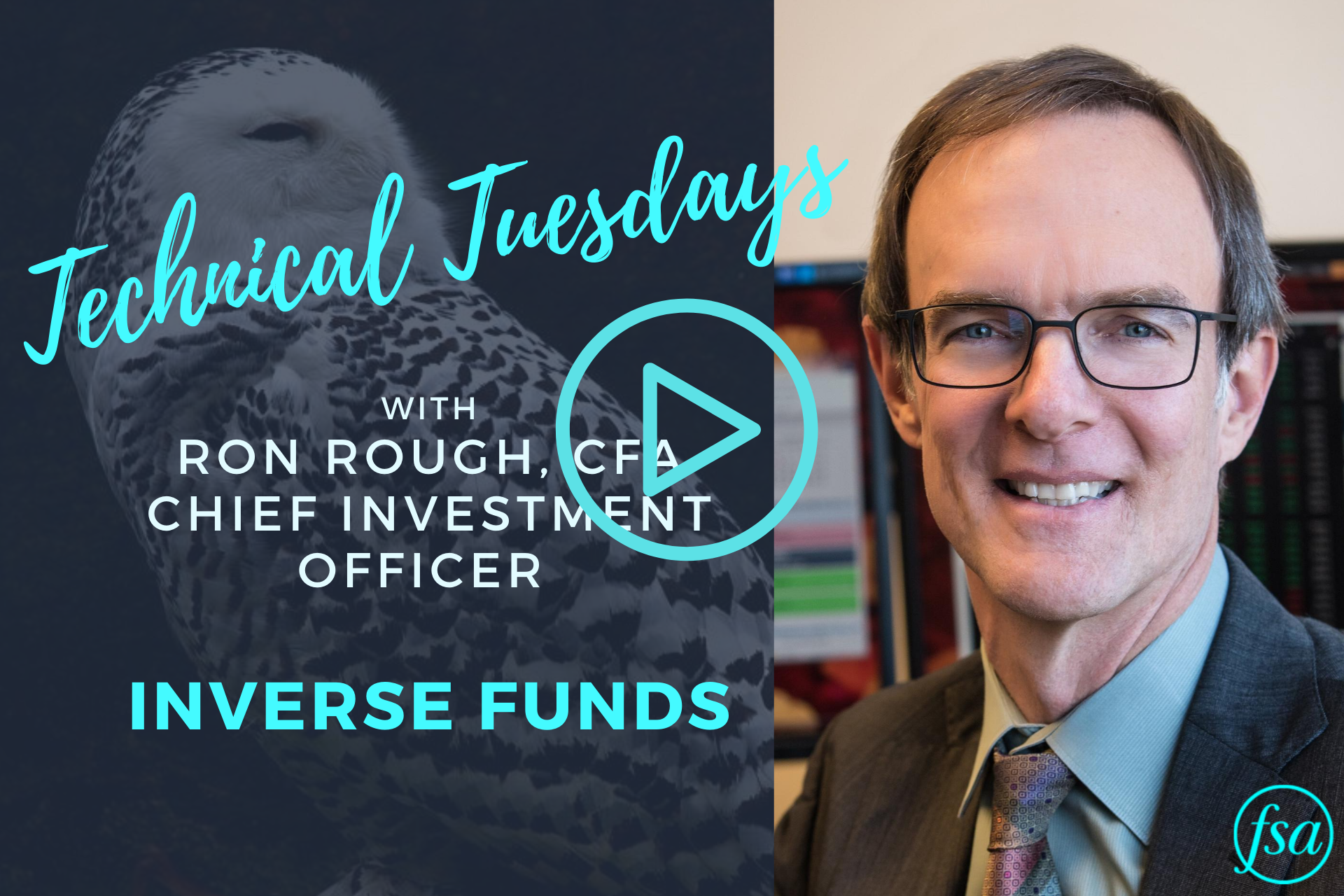Ron Rough, Chief Investment Officer, explains what inverse funds are and how FSA uses them as a risk management tool.
Inverse Funds Transcript
Hello, this is Ron Rough with the Technical Tuesday video. In this edition, we’re going to cover inverse funds. Inverse funds are a risk management tool that we use at FSA. The most common risk management tool we use is the FSA Safety Net, of course. The inverse line is just another tool that we can use.
So let’s talk about what they are exactly. They’ve been around for a long time. They came out, I think, in the mid-’90s, and today there are hundreds of inverse funds, ETFs, and mutual funds that we can use, so it’s a very broad asset class for us to access to help protect the portfolios. In an inverse fund, as the name suggests, when the prices of an index go down, say, in the stock market, inverse funds are designed to go up. And then conversely, if prices are going up in the stock market, inverse funds will go down.
So if you think about the S&P 500, we have periods where prices are going higher, and periods where prices are going lower. If we could overlay an inverse fund during those falling periods, it would allow us to have a security in the portfolio that was actually making money while the overall market was falling.
So where would we want to use funds like that in the portfolios? Well, number one would be in these transition periods that we see. We often talk at FSA about rising markets, falling markets, and these choppy transition periods that we call landings. In these landings, we’re not sure if ultimately stock prices are going to go higher or lower and end up tripping through our safety nets. We can add inverse funds in these transition periods that allow us to give it some time to see what is going to happen ultimately. Are stock prices going to ultimately go higher or are they going to roll over? If they roll over, we’ll end up selling whatever funds we have in the portfolio, but the inverse funds allow us to hold some good funds in the portfolio while we’re going through this transition period.
Secondly, we’ll use inverse funds to protect one of our core funds, one of our managed low-risk funds that we often hold in the portfolio for the long run. They might be doing quite well, and even in relation to what the stock market’s doing, they may be holding up pretty well even though they’re falling. We can have an inverse fund to protect those, keep the portfolio from losing money, and yet at the same time, be able to hold these funds of ours that have done well and that we’d like to hold. Obviously, for taxable accounts, there can also be reasons to hold it, hold a fund in a taxable account. Maybe it’s going to go from a long-term capital gain to, or I’m sorry, a short-term capital gain to a long-term capital gain. So we might want to hold it until that happens. So there’s sometimes tax reasons that we would want to hold a fund, and therefore use an inverse fund rather than just selling the fund outright.
Broadly speaking, the use of inverse funds just help us with fund relations. Sometimes, if we sell a fund we can’t buy it back for a period of time, sometimes helping us manage the flows of money in and out of a ETF or mutual fund. So there are a number of reasons that inverse funds are just a good tool for us.
And then finally, in extended bear markets, an inverse fund can actually give us the opportunity to make money in a falling market. If we’ve sold most of our funds because they’ve tripped through the FSA Safety Net and we have one or two or three inverse funds in the portfolio, the portfolio actually could make money if the stock market continues to fall. During those periods, the market is usually very volatile, so it’s not necessarily easy to do, but it certainly is an opportunity for us in an extended bear market.
So those are the reasons that we would use inverse funds in the portfolio. And I think you’ll see as time goes by that there are opportunities to use this and help us do a good job at managing risk.
So if you have any questions about the content of this video, please email or call us. So until next time, thank you for watching.
FSA’s current written Disclosure Brochure and Privacy Notice discussing our current advisory services and fees is available at www.FSAinvest.com/disclosures or by calling 301-949-7300.




